7 Best AI Blog Post Generators of 2024 (Ranked)

Tired of missing deadlines?
Hate writer’s block?
What if there’s a smarter, quicker way to write your blog posts?
The right AI blog post generator can make all the difference.
And in this article, I’ll share the best blog post generators you can use to build a content creation process.
Let’s dive right in.
What Are the Best AI Blog Post Generator Tools?
Here are the best AI blog post generator tools.
1. ChatGPT
Best for All-Round Blog Generation
Imagine an AI tool that can grasp your article’s search intent based on an initial prompt.
It then decides the best way to build your article is to create a fully-fledged outline.
That AI tool is ChatGPT.
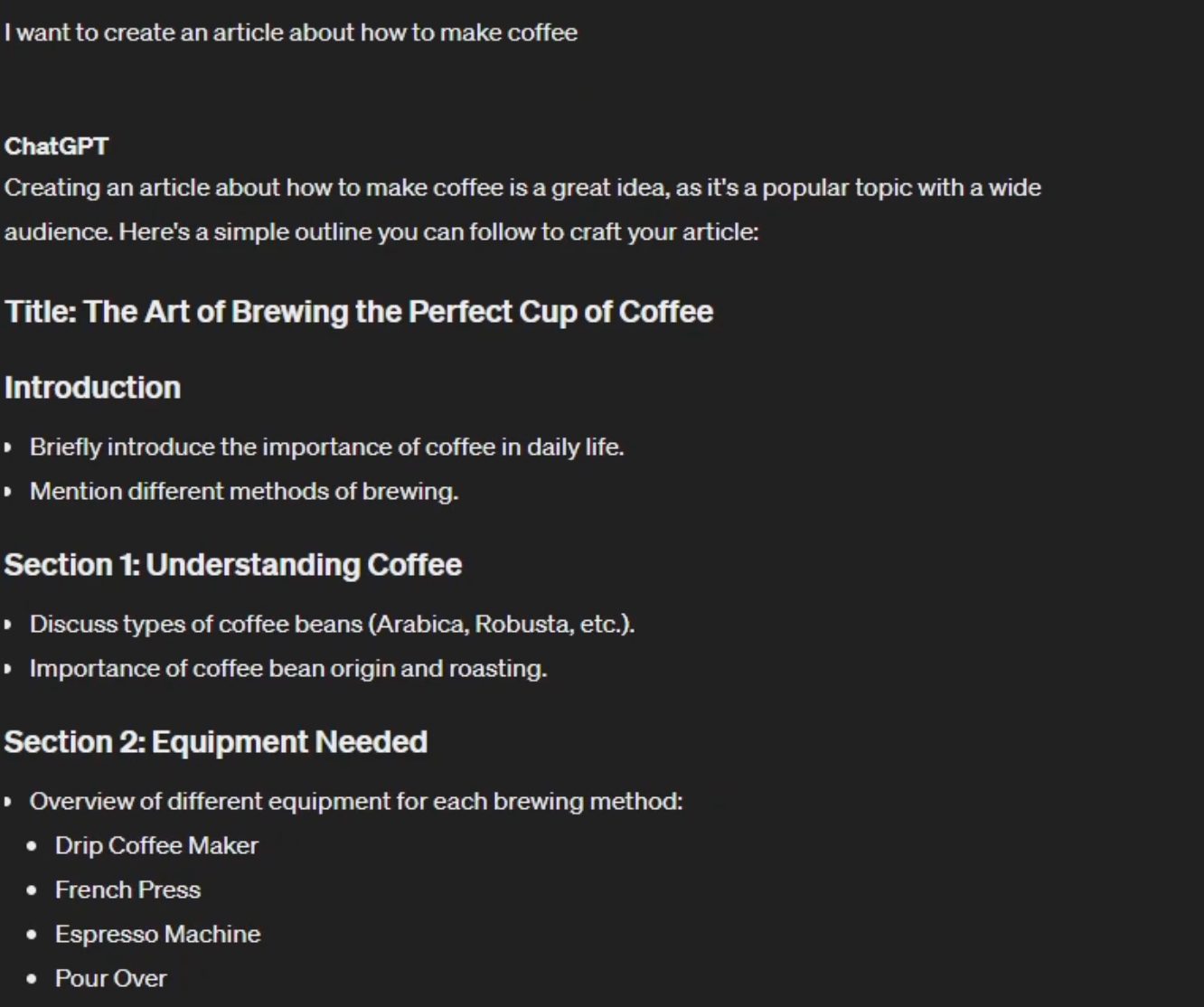
After you have the outline, you can use ChatGPT to create your article (or multiple ones) as needed.
You can even create multiple articles targeting different angles – or go back to the drawing board if you don’t like the output.
And the best part is that you communicate with ChatGPT just like you talk to another person.
You can even get ChatGPT to produce your article’s titles, meta descriptions, and alternative SEO keywords.

You can also add personal anecdotes as part of your blog post – all done through the power of ChatGPT.
Key Features
- Outline Generation: ChatGPT makes creating outlines easy. The AI then prepares a fitting title, creates content, and sorts into well-defined sections.
- Content Customization: Do you need a story or a narrative twist? Do you want to add a personal anecdote? ChatGPT can do it all.
- Interactive Creation Process: You can work step by step (and section by section) to refine each article section.
Pros and Cons
Pros:
- Generates structured outlines effortlessly, turning vague ideas into detailed articles.
- It offers extensive customization through the right prompts.
- Encourages a hands-on approach to content development
Cons:
- The necessity for multiple interactions can extend the content development process.
- The quality of the output heavily relies on the user’s input prompts, which could frustrate beginners.
Final Verdict
Whether you want to create blog posts that educate, entertain, or both, ChatGPT can help you do the job well.
2. Claude.ai
Best for Blog Idea Generation
Claude AI is a direct ChatGPT competitor and another great AI blog post generator.
It helps users speed up the typical blog writing process by creating polished outlines that don’t require many changes.

Using a chat interface similar to ChatGPT, it guides you through the needed blog creation steps.
This is another excellent tool to check out if you want to create compelling, well-structured posts (with ease).
In my opinion, its free and paid versions match (and, in some cases, are superior) to ChatGPT’s outputs.

Key Features
- Dynamic Chat Interface: Start a conversation and receive real-time prompts that help outline and refine your content.
- Selection of Models: Choose from various AI models, each one more “intelligent” than the previous model.
- Structured Content Design: Effortlessly generates comprehensive outlines, breaking down articles into specific, detailed sections.
- Advanced Subscription Options: Access enhanced features, like priority status during peak times and more sophisticated AI models.
Pros and Cons
Pros:
- Quick generation of blog article sections and detailed article frameworks.
- Flexibility to select AI models tailored to the complexity and style of the content required.
- Streamlines the writing process by guiding users through every step.
Cons:
- You might have to subscribe if you want to use Claude more regularly. However, the free version is great for most users.
Final Verdict
Claude AI is an excellent tool for writers who want to produce high-quality blog posts.
The tool simplifies the creation process and uses an easy-to-understand interface.
Couple all this with a fast response time, and you get Claude AI.
All these features make it ideal for content creators who produce articles regularly.
3. Jasper
Best for Pre-Trained Blog Templates
Jasper is one of the original AI blog post generator tools.
Over time, it’s become a powerhouse that helps bloggers create blog posts quickly.
As a creator, you can streamline your blog creation process and produce various content types.
To do this, you can use either Jasper’s ready-made templates:
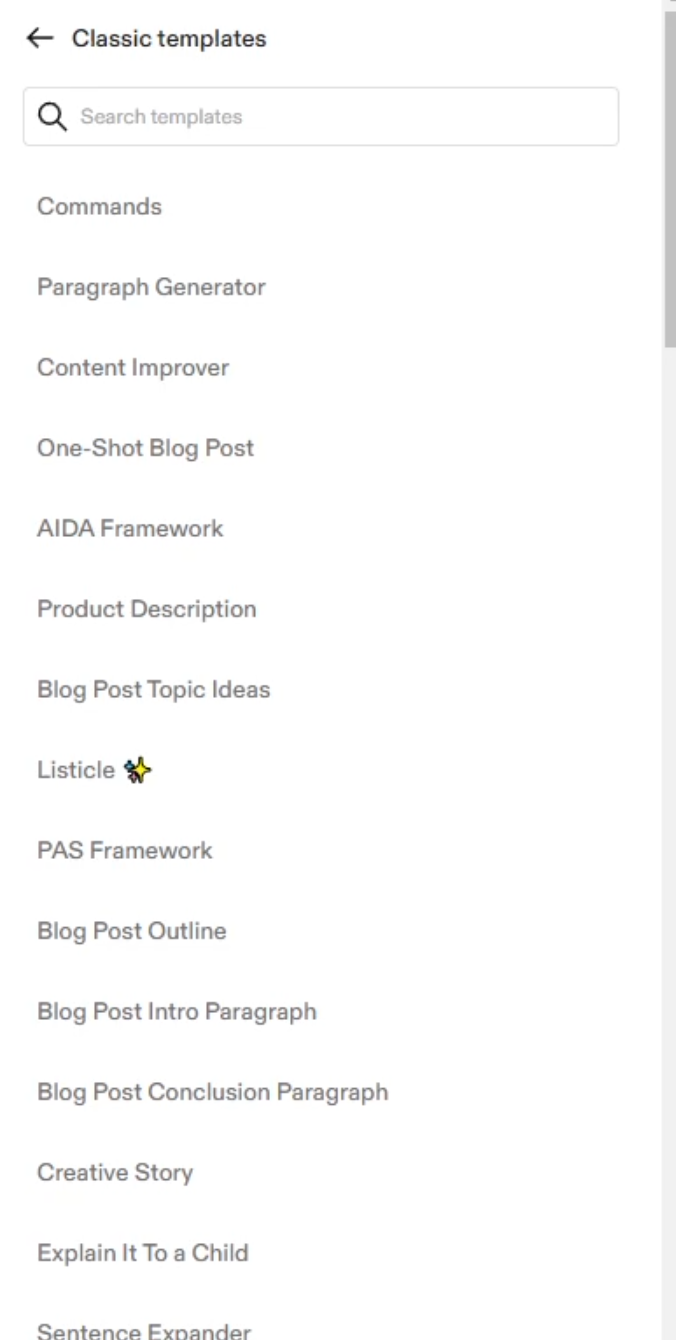
or a flexible “blank canvas”:

This dual approach is excellent for all levels of users.
You can also use their “one shot blog post” generator if you’re in a rush when creating blog post content.
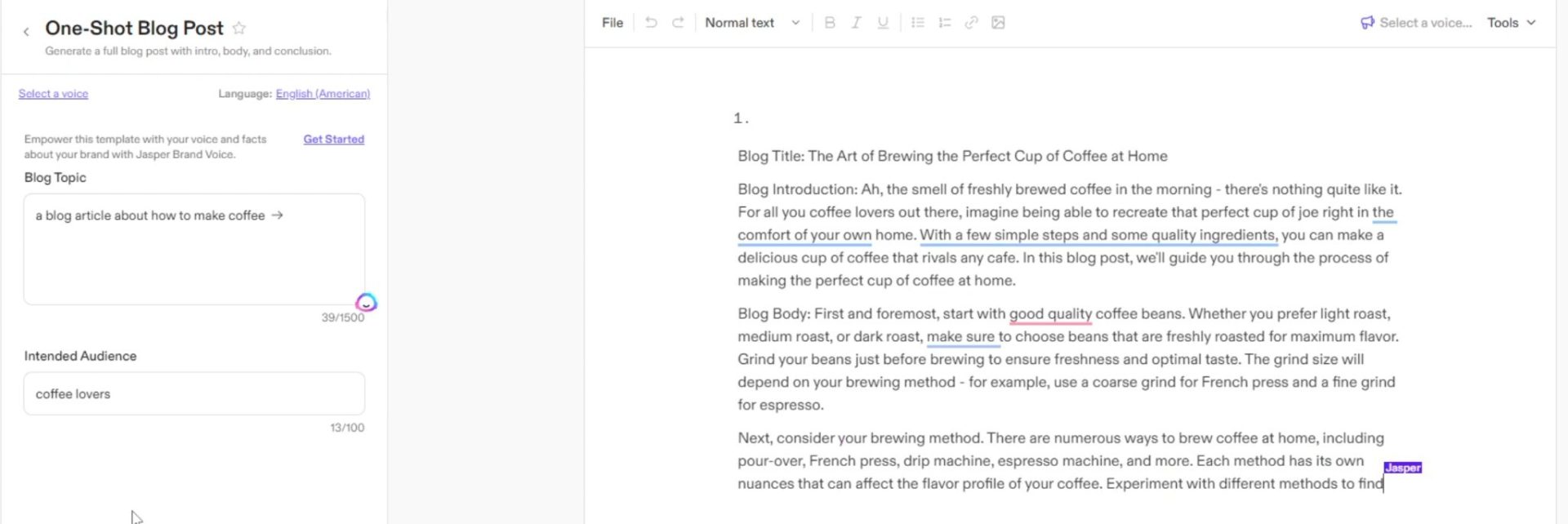
Key Features
- Diverse Pre-Trained Templates: Whether creating blog posts or engaging social media snippets, Jasper can help.
- Innovative Blank Canvas: The blank canvas makes it easy to start from scratch while using specific commands to get AI assistance.
- Audience Customization: Jasper is great at creating content for a specific target audience. It matches any tone and style to help your content resonate with your readers.
Pros and Cons
Pros:
- 70+ templates make content creation effortless.
- You can quickly turn drafts into engaging blog posts using various methods.
Cons:
- You might have to fine-tune your outputs to add a personal touch and establish authenticity.
Final Verdict
Jasper offers a great way for beginners to start their AI blog post-generation journey.
Jasper is worth considering if you want a reliable tool with proven templates.
4. Rytr
Best for Tone of Voice Selection
Rytr offers both a Chrome extension and its own interface to help bloggers create content.

This AI blog post generator also adapts to your unique writing style through a quick selection process.
If you want humanized content, the right selection makes this happen.
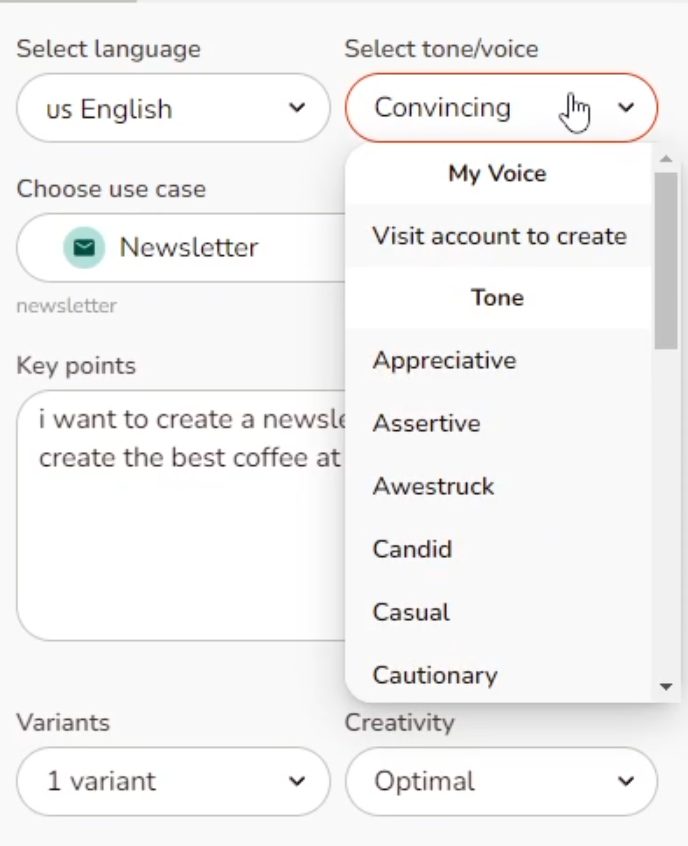
As an AI content generator, it offers plenty of templates for bloggers, marketers, and business strategists to help create quality content in minutes.
Here’s an example of me creating a newsletter in a few seconds.
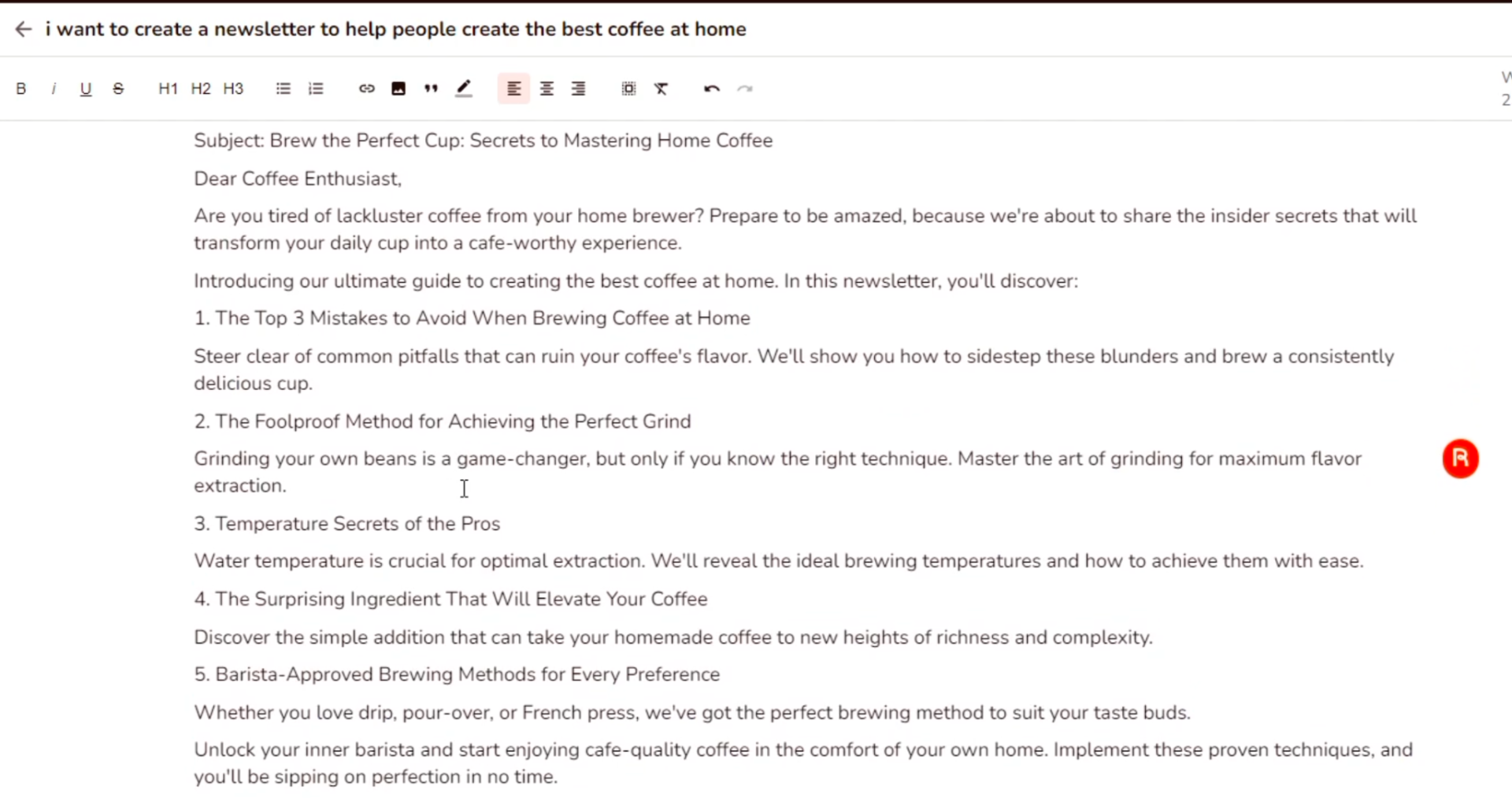
Key Features
- Diverse Writing Scenarios: Rytr can help brainstorm new blog ideas, outline articles, craft engaging newsletters, and more.
- Tonal Adaptability: The software works well when establishing a specific emotional tone. If you want your writing to be persuasive, appreciative, or light-hearted, just choose the right option from Rytr’s drop-down menu and hit generate.
- Accessibility Through a Free Version: Rytr’s commitment to accessibility is reflected in its free tier. This tier gives you a set amount of free credits every month.
Pros and Cons
Pros
- A Swiss Army Knife for Content: Rytr’s various use cases help users create blog posts on various topics. The result? More productive and creative writing.
- Emotional Range in Tone: It’s great to be able to fine-tune the voice of your AI-generated content. Many AI tools ask you to type this in, but Rytr allows you to choose through its drop-down menu.
- Generous Free Tier: For those testing the waters, Rytr’s free membership is a great way to get started (and might even be enough month after month).
Cons
- Credit System Limitations: While there is a free tier, you won’t get too far if you use Rytr consistently. In this case, you’ll have to upgrade to a paid subscription.
Final Verdict
Rytr helps bloggers get the job done.
With the ability to customize the tone and writing style, the platform is a great AI blog post generator.
Overall, it’s an excellent tool for anyone who relies on digital storytelling to make an impact through various output mediums.
5. Writesonic
Best for Generating Content Through AI Chat

Writesonic is a tool that uses AI chat to its advantage.
Bloggers can “speak” to the AI and get content ideas, summaries or even whole sections generated based on the prompts they give.
 Writesonic is also quite versatile when generating content.
Writesonic is also quite versatile when generating content.
The tool can create anything from:
- structured outlines to help with the creation process to
- blog posts that already have images within them.
Here’s an example of the top section of a finished article draft straight out of the tool:
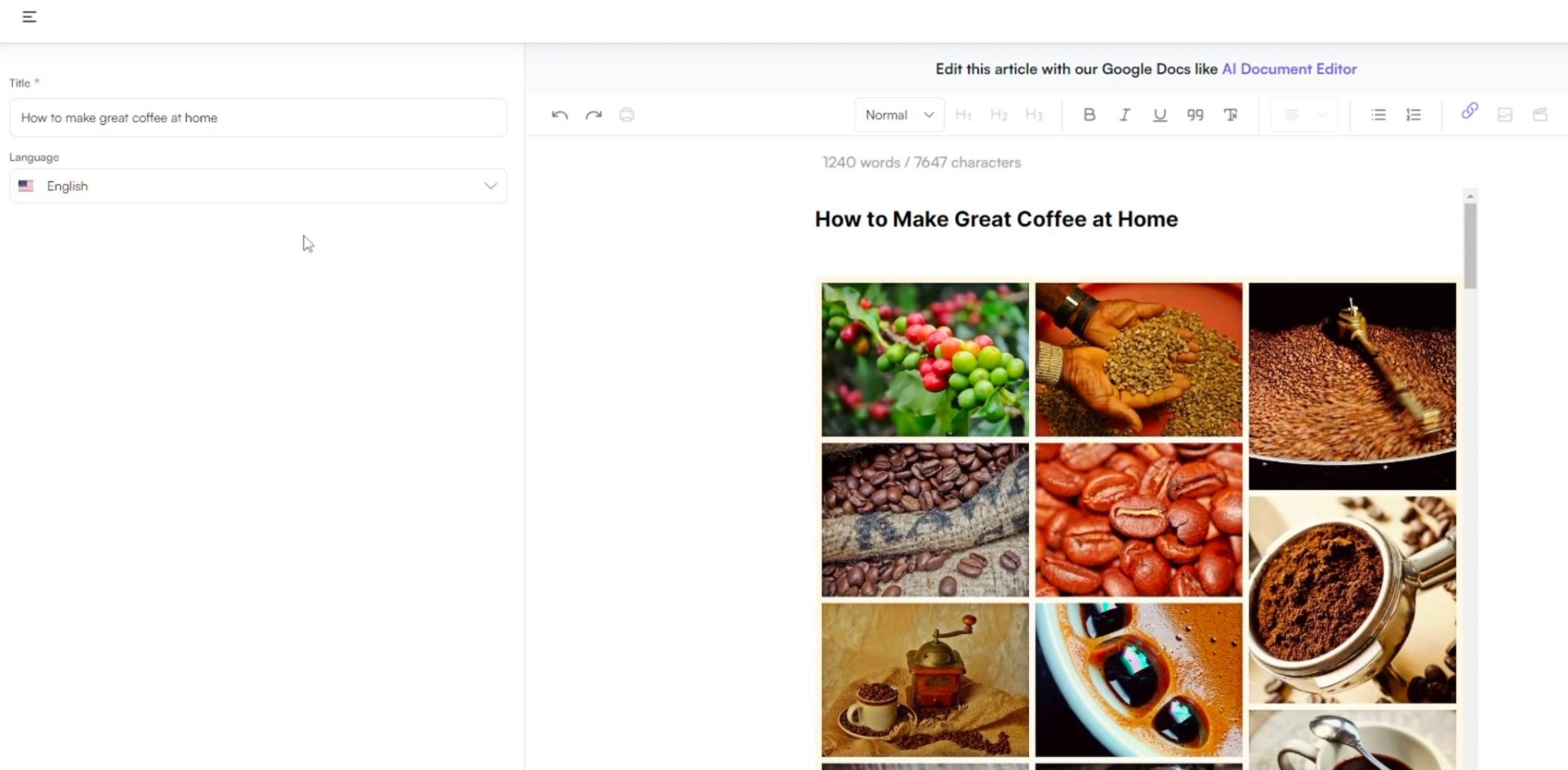
Key Features
- Diverse Writing Modes: You can use their ‘Guided Article Writer’ to add personal insights to your article. Then, let AI do the building. There’s also an ‘Instant Article Writer’ for faster content creation.
- Template and Customizable Content Creation: With pre-set frameworks, you can draft content according to your needs. You can also provide source data when creating articles on specific topics.
- Interactive Chatbot Integration: Writesonic uses a chatbot within the user interface. This chatbot is excellent for communicating with the user and adding relevant touches to your content.
Pros and Cons
Pros:
- Adaptive Content Solutions: Writesonic offers multiple content creation tools to help bloggers hit their goals.
- Intuitive User Experience: The interface is very navigable and accessible. It’s easy to use as a first-time user – no learning curve required.
- Efficient Production: It’s straightforward to create a workflow that creates the right article drafts.
Cons:
- Formatting Needs: Sometimes, you must perform additional formatting tweaks to ensure your article is ready to publish.
- Template Reliance: I noticed that drafts don’t always fit the chosen tone and writing style. You might have to tweak the article to ensure it fits your needs.
Final Verdict
Writesonic is a great tool to optimize your content creation workflow.
It combines speed with a range of output options.
Users may need to optimize their articles – especially regarding formatting.
6. Copy.ai
Best for Blogging Task Automation
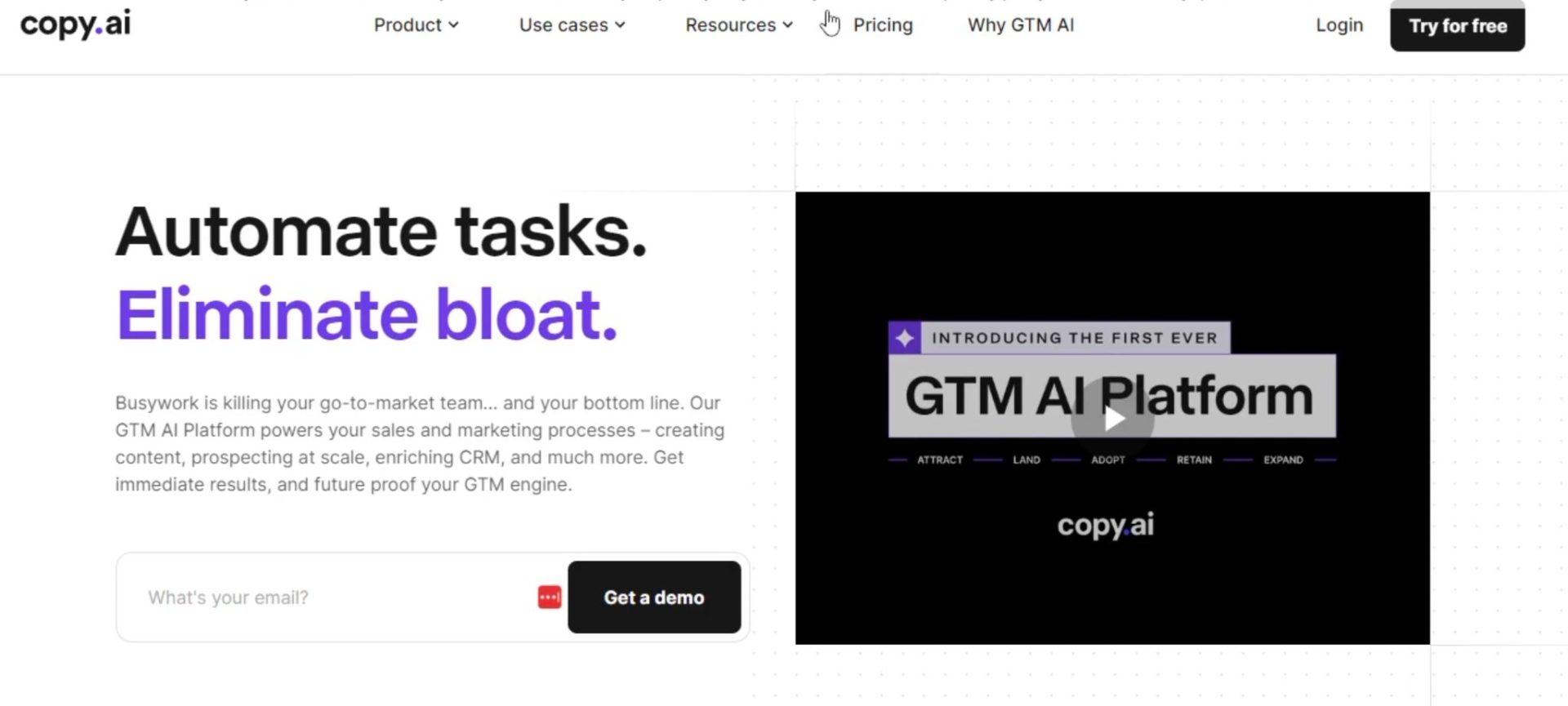
Copy.ai uses the power of GPT models to semi-automate blog post creation.
It uses several templates to make the writer’s job much easier.
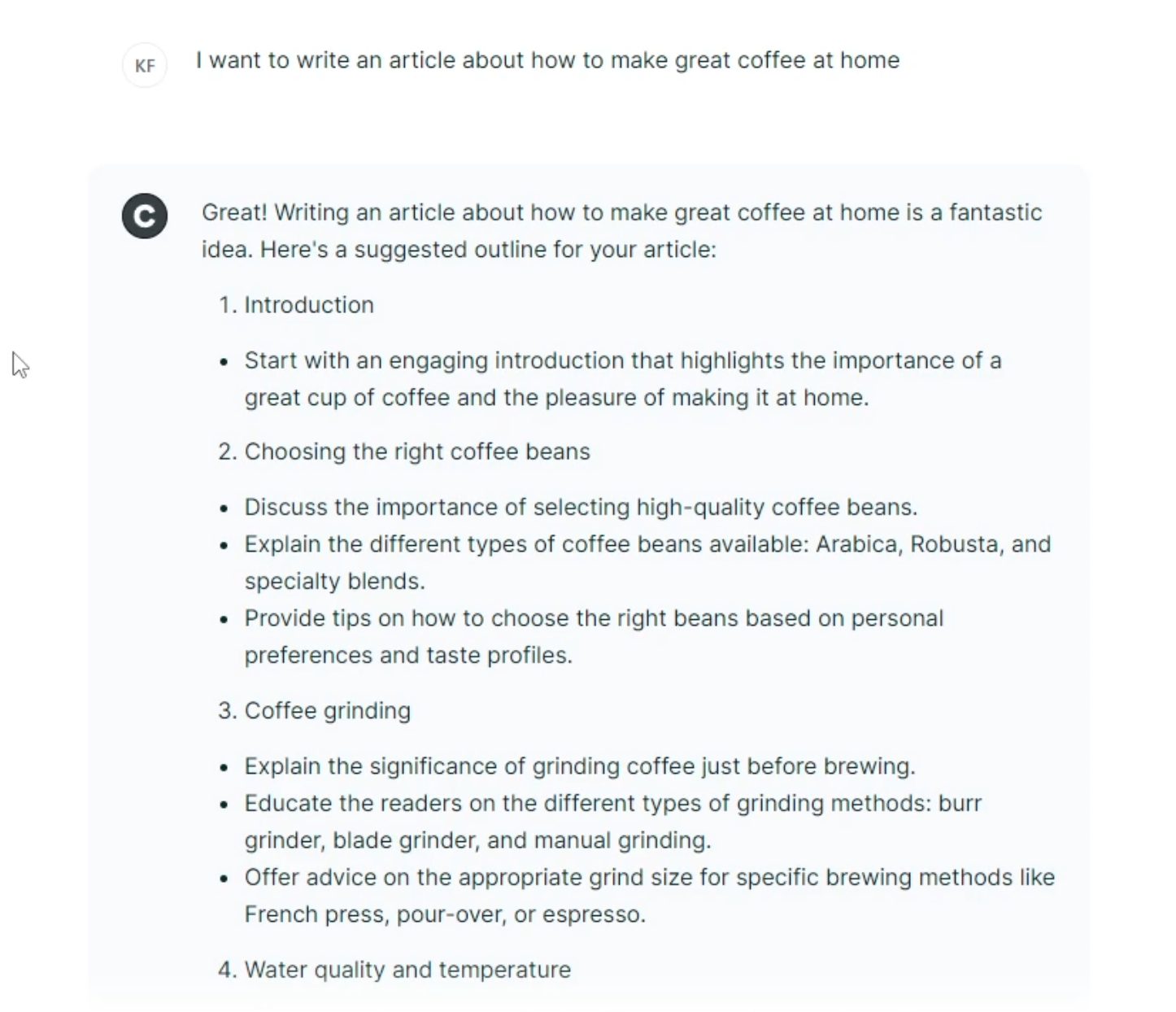
These templates make moving from one step of the content creation process to the next seamless.
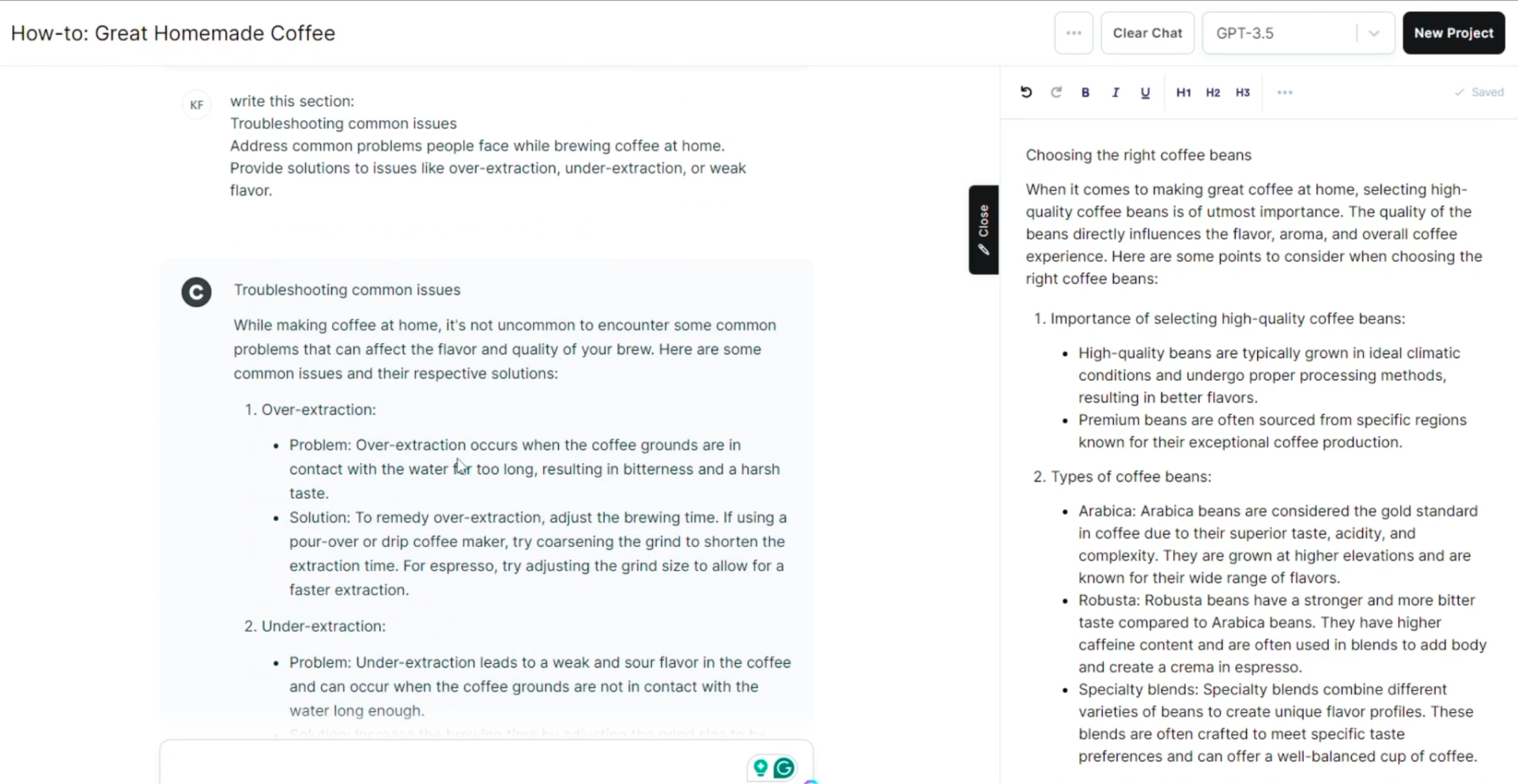
Key Features:
- Diverse Model Accessibility: Copy.ai uses GPT-3.5 and GPT-4 to create content. Note that it reserves advanced functionalities for the pro version.
- Structured Content Generation: Copy.ai helps users create and flesh out content outlines in a structured manner. The result? Great content on any given topic.
Pros and Cons:
- Pros:
- User-friendly navigation and selection within Copy.ai’s content generation toolkit.
- Quick and detailed outline generation. You can then expand on each point and create detailed article sections.
- Copy.ai offers two screen areas – a working area and another area to keep all the finalized work. This split-screen method is a great way to get the job done.
- Cons:
- Premium features (including access to GPT-4) are exclusive to the pro version.
- Generating high-quality content depends on user input, which might take some time to get used to for new users.
Final Verdict
Copy.ai is a great tool for transforming the content creation landscape.
However, most of its advanced tools are only available through a paid subscription.
7. GravityWrite
Ideal for Content Output Types
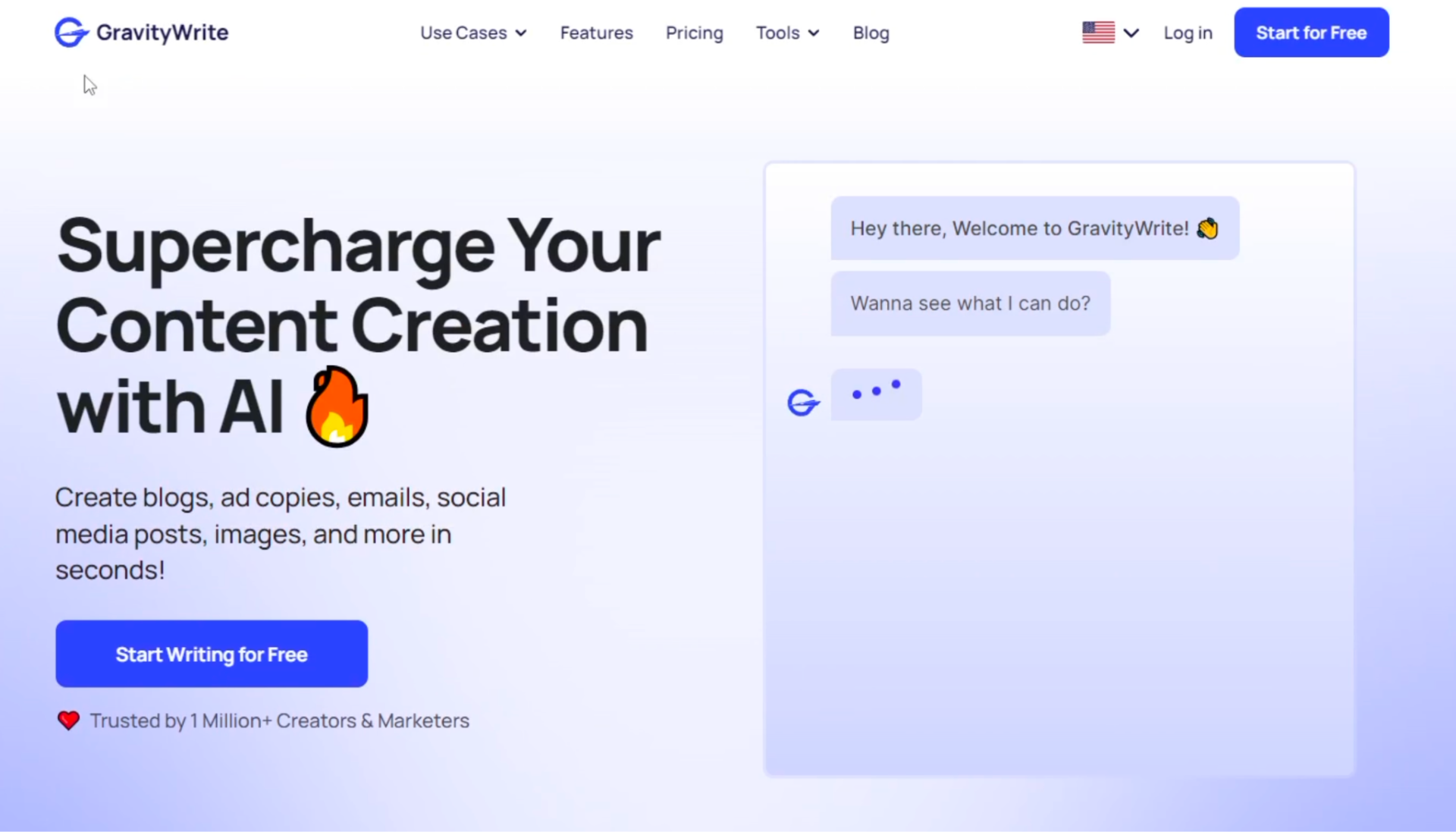
GravityWrite is an AI writing tool that transforms how you write into a seamless experience.
It helps anyone from casual bloggers to detailed academic researchers create their desired posts.
With the various templates, GravityWrite ensures your content is top-notch.
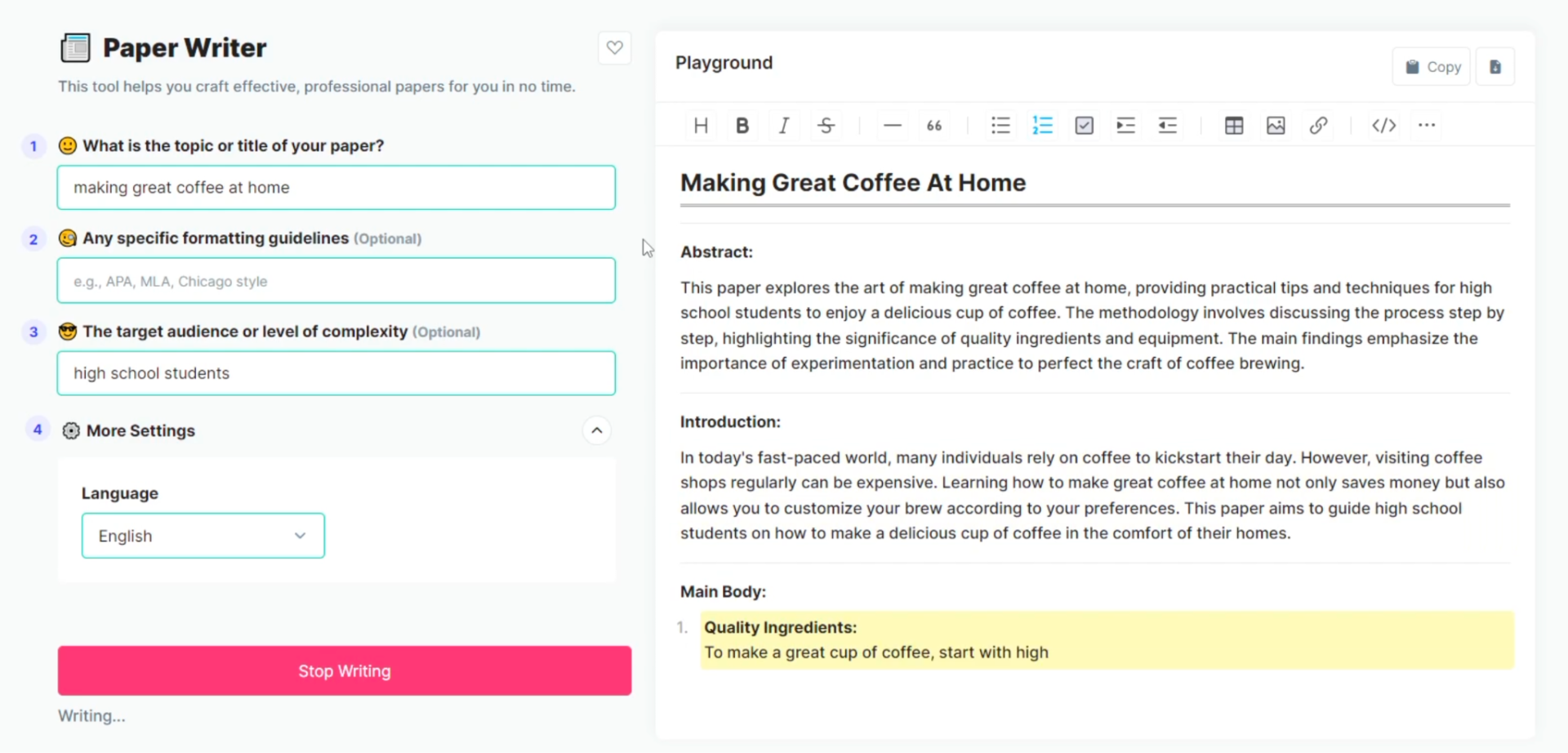
Key Features:
- Multifaceted Writing Assistant: From intricate academic essays to simple personal messages, GravityWrite combines your thoughts into structured formats.
- Tailored Content Creation: Whether you’re after a punchy YouTube script or a detailed SEO article, this tool adapts to your specific needs.
- Rich Template Repository: Explore various pre-designed frameworks to get the job done.
Pros and Cons
Pros:
- User-centric Design: The platform’s intuitive interface makes it easy for users with varied technical skills.
- Expansive Template Selection: Plenty of templates help make the most of the user’s creativity and ensure consistency.
Cons:
- Customization Constraints: The platform may be a bit flat when it comes to how it formats the articles
Final Verdict:
GravityWrite’s strength lies in its ability to help with content creation for different needs.
Content that demands a high degree of personalization can feel a bit limited.
However, if you’re after blog post writing in more “common topics”, this tool can be a great option.
What Is an AI Blog Post Generator?
An AI blog post generator is a tool bloggers use to develop content ideas and flash them out into articles.
Some tools offer integrations with content management systems (such as WordPress) to make publishing easier.
AI writing tools generally require a few key steps to work:
- The user selects a template to get started/writes the correct prompts
- The AI tool processes the input and generates an output
- The user and the AI tool go back and forth to produce the desired output
- The user polishes the output based on their specific requirements.
Some tools then have more advanced features for further customization.
Benefits Of Using An AI Blog Post Generator
Creating content is fun. It’s also a time-consuming task.
First, the creator needs to research the article. Based on their level of expertise, this can take anywhere from a few minutes to a few hours.
Then, the writer must craft an outline to include all the main points in the article.
The writer must also come up with stories, stats, and references to support their points.
After this initial process, the writer must type it all out.
Finally, there’s the editing process. This is another process in and of itself.
If you’ve ever written a long-form blog post article, you know how much work goes into the final product.
And don’t even get me started on writer’s block or struggling to come up with fresh, relevant ideas for content.
An AI blog post generator can help with almost all the above steps.
It can:
- Generate ideas: writers can say goodbye to writer’s block.
- Save time: the AI tool can draft outlines and the article itself. It can expand on points or even shorten those that are too long.
- Improve SEO: AI blog post generator tools can suggest relevant keywords to make your articles more SEO-friendly.
- Help with repetitive tasks: When it comes to repetitive processes, artificial intelligence can also lend a hand and automate these tasks.
Key Factors When Choosing A Blog Post Generator
Consider the following factors before deciding on your AI blog post generator:
- Features: have a list of items you must accomplish in your completed blog post? Does the AI tool you’re considering help with all (or most) of these items?
- Pricing: Does the tool offer a free trial to test it out? If it does, does the trial period allow you to test the tool thoroughly? What about the tool’s paid plans? Does it use a credit system? If it does, you might risk ending up without credits.
- Target audience: Does the tool allow you to create content for a specific audience? Or has the AI tool been trained on data that doesn’t factor in your ideal persona?
- Ease of use: Is there a long learning curve? Will you have to spend (waste) several hours to get up to speed? Or is it easy to log in and start using the tool?
These are all factors to consider before making a final decision.
Will AI Writers Take Over the Human Writer’s Job?
In a nutshell, I don’t think so.
The human writer is still needed when it comes to blog post writing. And I think this will remain true – at least for the short term.
The human writer is responsible for:
- Originality and creativity within an article
- Fact-checking
- Adding personal stories
- And much more.
While there are aspects an AI blog post generator can do better than humans, the opposite is also true.
As such, the human writer who uses an AI writing assistant well will ultimately win.
Conclusion
AI blog post generators are revolutionizing the way bloggers approach content creation.
With the right AI tool, you can:
- overcome writer’s block
- speed up your writing process and even
- enhance your creativity.
When you embrace AI blog post generators (and use them correctly), you’re not only saving time. You’re also creating better quality content your followers will love.
Just remember that AI isn’t a complete solution to blog post writing.
Your input is still very much needed.
Further reading on AdamEnfroy.com: Want more info on AI tools? Check out the best free AI content generator to kick off your journey – without paying a cent.
If you’re curious about more options, check out my guide on the best AI content generator options.
And if you want to learn specifics, read this article on how to use AI to write articles that rank.
If copywriting is your focus, take advantage of this article on the best AI copywriting software tools.





